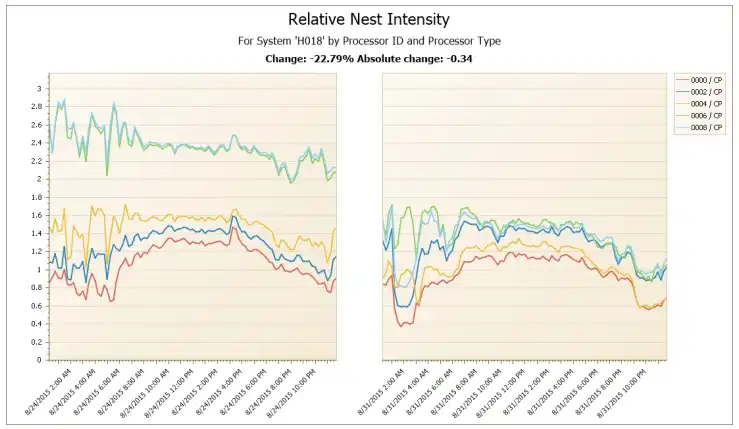In August, IBM announced their annual 4% increase in z Systems Monthly License Charge (MLC) software prices. It was indicated in the announcement letter that the timing of the announcement is designed to give customers sufficient lead time to adjust their budgets for the following year. This cost increase may put additional strain on a lot of already tight budgets and force some shops to make unpleasant decisions. We at IntelliMagic think you have a better alternative to the MLC expense increases.
For several months, IntelliMagic has been delivering free MLC Reduction Assessments showing mainframe sites ways MLC expenses can be reduced. These assessments unleash the visibility provided by IntelliMagic Vision into SMF data from your environment, exploring several potential areas of opportunity for savings. And for a majority of mainframe sites we have been able to help identify significant potential MLC reductions through these assessments.
Processor Cache Efficiency
One of the primary areas of our analysis is processor cache efficiency, which has a greater impact on delivered capacity on z13 processors than ever before. This happens because the clock speed on the z13 is 10% slower than its zEC12 predecessor, yet the processor capacity rating is 10% higher. Achieving that increased capacity is therefore highly dependent on the effective utilization of processor cache.
And yet, more than 80% of attendees of our recent Beyond Capping: Significantly Reduce z13 MLC with Processor Cache Optimization webinars reported they had not started the analysis of processor cache efficiency and were not aware of the values of the associated key metrics in their environments. IntelliMagic Vision provides unparalleled visibility into processor cache metrics (as well as across the spectrum of systems, storage, and virtual tape infrastructures).
Need for Modernizing SMF Processing
This highlights one of the key factors driving the need for modernizing the approach to processing and interpreting SMF data. The traditional approach of each site executing their home-grown systems to process SMF data tends to fall behind developing the code necessary to support and interpret relatively new data sources like the SMF 113 records critical to processor cache analysis.
Large page and zEDC metrics are examples of other recently emerging technologies for which many sites are behind the analysis curve. There are typically hundreds of metrics associated with each new technology. But what do the new metrics mean? Which ones are important? What values are good or bad? These are the questions we help mainframe shops answer.
This visibility deficit is likely to become even more pronounced in the coming years as many of the highly skilled mainframe performance analysts responsible for developing these local SMF processing systems retire from the workforce.
Another key factor driving the need for SMF modernization is that no one has the time (or inclination) to routinely check the health of the thousands of elements in their z/OS systems, storage, and virtual tape infrastructure to identify potential risks to availability. These risks may be right around the corner as business workloads increase.
MLC Reduction Assessments
Most of the MLC Reduction Assessments we have delivered to date have indicated opportunities for savings. Several of them have revealed a likely 7-figure annual MLC reduction savings. And no matter the MLC outlook, the presentations of these assessments and associated demos leveraging IntelliMagic Vision are providing technical teams with new visibility into data from their environments across the broad spectrum of their systems infrastructure. This visibility has (as you might expect) generated highly-engaged discussions on potential improvements going forward.
A final note, sites considering moving to a Country Multiplex Pricing (CMP) licensing model or evaluating the acquisition of an automated capping product are strongly encouraged to first engage IntelliMagic for a no-cost MLC Reduction Assessment. Reducing current MLC expenses could significantly lower your CMP baseline, resulting in savings for the lifetime of that contract. In addition, because license models for capping products are often based on incremental MLC savings, reducing your MLC baseline before entering into that agreement can also result in significant savings.
To receive a no-cost, no obligation MLC Reduction Assessment utilizing data from your own environment, please contact us
This article's author
Share this blog
Related Resources
Why Am I Still Seeing zIIP Eligible Work?
zIIP-eligible CPU consumption that overflows onto general purpose CPs (GCPs) – known as “zIIP crossover” - is a key focal point for software cost savings. However, despite your meticulous efforts, it is possible that zIIP crossover work is still consuming GCP cycles unnecessarily.
Top ‘IntelliMagic zAcademy’ Webinars of 2023
View the top rated mainframe performance webinars of 2023 covering insights on the z16, overcoming skills gap challenges, understanding z/OS configuration, and more!
Mainframe Software Cost Savings Playbook
Learn how to effectively reduce mainframe costs and discover strategies for tracking IBM software licensing metrics to minimize expenses.
Book a Demo or Connect With an Expert
Discuss your technical or sales-related questions with our mainframe experts today


 Todd Havekost
Todd Havekost